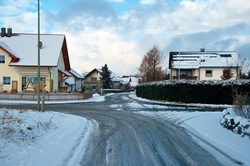
It happens with alarming frequency in bitter cold winters like this one. I’ll be taking my dogs for a walk in my suburban neighborhood, passing one large single-family home after another, and no one on the sidewalk but me, when it strikes me that there’s something wrong with this picture. On the surface, everything appears just fine: the neighbors are either ensconced in their oil or natural gas-warmed homes, or have driven away in their gasoline-powered cars. But out of sight is a remote, global network of petroleum and natural gas excavators, refiners and distributors upon which the entire neighborhood depends, and that’s what worries me. On those solitary dog walks, I can’t shake off a nagging concern that someday that network will collapse or prices will rise so high that we’ll have to scramble to find a way to stay warm and get to work, the supermarket and other places unreachable by foot.
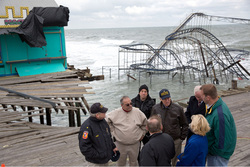 (Official White House Photo, Sonya Herbert)
(Official White House Photo, Sonya Herbert) Kicking the Outsourcing Habit
There’s good reason for this concern, particularly in the case of oil. To prepare for severe shortages, the US Strategic Petroleum Reserve has stored enough oil in four sites in the Gulf of Mexico to sustain this country for 36 days. The current inventory is 695.9 million barrels, or 36 days of oil at current daily US consumption levels. Even if that oil turns out to be enough to get us through the worst of oil crises, what will we do in the long run, when, as many scientists predict, supplies of relatively cheap, easily accessible oil run out? Or in the short run, if a natural disaster makes it impossible to transport oil from the Gulf of Mexico to other parts of the country?
This is exactly what happened in November of 2012. Within three days after Hurricane Sandy’s winds subsided, gas lines not seen since the 1970s formed across the New York metropolitan area. Sandy also downed countless trees, leaving millions without power. The hurricane drove home not only how vulnerable our built environment is to major storms, but also how much we’ve come to rely on distant suppliers for energy as well as for food, clothing, household goods and other essentials. Ironically, this outsourcing habit is powered by the combustion of fossil fuels like oil, natural gas and coal, which yield carbon dioxide and other greenhouse gases linked to global climate change, which scientists peg as the likely cause of today’s rising frequency of severe storms.
There’s good reason for this concern, particularly in the case of oil. To prepare for severe shortages, the US Strategic Petroleum Reserve has stored enough oil in four sites in the Gulf of Mexico to sustain this country for 36 days. The current inventory is 695.9 million barrels, or 36 days of oil at current daily US consumption levels. Even if that oil turns out to be enough to get us through the worst of oil crises, what will we do in the long run, when, as many scientists predict, supplies of relatively cheap, easily accessible oil run out? Or in the short run, if a natural disaster makes it impossible to transport oil from the Gulf of Mexico to other parts of the country?
This is exactly what happened in November of 2012. Within three days after Hurricane Sandy’s winds subsided, gas lines not seen since the 1970s formed across the New York metropolitan area. Sandy also downed countless trees, leaving millions without power. The hurricane drove home not only how vulnerable our built environment is to major storms, but also how much we’ve come to rely on distant suppliers for energy as well as for food, clothing, household goods and other essentials. Ironically, this outsourcing habit is powered by the combustion of fossil fuels like oil, natural gas and coal, which yield carbon dioxide and other greenhouse gases linked to global climate change, which scientists peg as the likely cause of today’s rising frequency of severe storms.
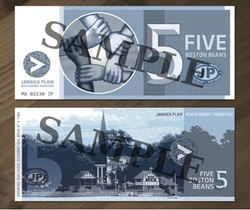 (Source: JP New Economy Transition)
(Source: JP New Economy Transition) Transitioning to Post-Carbon Living
Angling to kick the outsourcing habit amid concerns about Peak Oil, a warming planet and economic instability, some 26 groups throughout New England—part of 146 in the U.S. and 470 worldwide—are now in-sourcing instead. They’re working to transform their communities into walkable, post-carbon “Transition Towns” that are well-prepared to survive and thrive without relying on nonrenewable fossil fuels. Raising awareness, collaborating with multiple stakeholders and taking concerted action, they’re striving to build local resilience by empowering residents to produce and consume as much as possible of life’s essentials as close as possible to where they live.
One such Transition initiative—the only one in Boston—is Jamaica Plain New Economy Transition (JP NET), a three-year-old organization that has launched or supported several projects designed to cultivate local, equitable and sustainable agriculture, energy and transportation systems, manufacturing and building, business and capital, and other critical community resources.
Examples include the Boston Bean, a JP NET-produced five dollar bill honored at selected JP merchants last winter to boost the local economy during the holiday season; Egleston Community Orchard, a formerly vacant, crime-ridden lot that neighbors converted into a garden space where apple trees, raspberries, blueberries, chard, kale and other crops are grown sustainably; and JP Green House, a passive solar-heated, highly insulated demonstration home near the Forest Hills T stop that maintains an average indoor temperature of 63 degrees in the winter.
Angling to kick the outsourcing habit amid concerns about Peak Oil, a warming planet and economic instability, some 26 groups throughout New England—part of 146 in the U.S. and 470 worldwide—are now in-sourcing instead. They’re working to transform their communities into walkable, post-carbon “Transition Towns” that are well-prepared to survive and thrive without relying on nonrenewable fossil fuels. Raising awareness, collaborating with multiple stakeholders and taking concerted action, they’re striving to build local resilience by empowering residents to produce and consume as much as possible of life’s essentials as close as possible to where they live.
One such Transition initiative—the only one in Boston—is Jamaica Plain New Economy Transition (JP NET), a three-year-old organization that has launched or supported several projects designed to cultivate local, equitable and sustainable agriculture, energy and transportation systems, manufacturing and building, business and capital, and other critical community resources.
Examples include the Boston Bean, a JP NET-produced five dollar bill honored at selected JP merchants last winter to boost the local economy during the holiday season; Egleston Community Orchard, a formerly vacant, crime-ridden lot that neighbors converted into a garden space where apple trees, raspberries, blueberries, chard, kale and other crops are grown sustainably; and JP Green House, a passive solar-heated, highly insulated demonstration home near the Forest Hills T stop that maintains an average indoor temperature of 63 degrees in the winter.
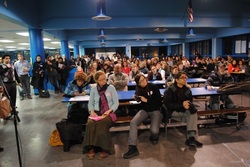 (Source: JP New Economy Transition)
(Source: JP New Economy Transition) Reclaiming the Neighborhood
As JP NET volunteers work together to advance these and other initiatives designed to wean JP off of nonrenewable fossil fuels, they are also transforming their community into a greener, more neighborly place, where more and more people are engaging in meaningful work to improve the quality of life for themselves and future generations of residents. The result is a more cohesive and deeply rooted hometown that connects everyone to their land, their neighbors and the larger history of which they are a part.
Dakota Butterfield, coordinator of the Boston Bean and an activist for Legalize Chickens in Boston, observes that while fossil fuels, piped in from remote sources, have improved so-called living standards and increased mobility, they have also enabled the citizens of industrialized countries to live remarkably isolated lives, whether in their cars, cubicles or single-family homes—rootless lives disconnected from the land and people that surround them. Lives symbolized by the empty sidewalks I so often encounter with my dogs during our neighborhood jaunts. “We don’t need each other anymore,” Butterfield laments.
By shifting our cultural paradigm from outsourcing to insourcing—from globalization to relocalization—we can overcome this isolation while dramatically improving the capacity of our communities to survive and thrive. To transition today’s global fossil fuel network to tomorrow's locally resilient network of post-carbon hometowns, we’ll need to work together, from the neighborhood to the bioregion level, to cultivate and promote local, renewable sources for food, energy, housing, commerce and more. As a result, as I take my dogs for walks around the block, even in the dead of winter, I will hopefully run into more neighbors, and run out of those nagging concerns about the future of the neighborhood.
As JP NET volunteers work together to advance these and other initiatives designed to wean JP off of nonrenewable fossil fuels, they are also transforming their community into a greener, more neighborly place, where more and more people are engaging in meaningful work to improve the quality of life for themselves and future generations of residents. The result is a more cohesive and deeply rooted hometown that connects everyone to their land, their neighbors and the larger history of which they are a part.
Dakota Butterfield, coordinator of the Boston Bean and an activist for Legalize Chickens in Boston, observes that while fossil fuels, piped in from remote sources, have improved so-called living standards and increased mobility, they have also enabled the citizens of industrialized countries to live remarkably isolated lives, whether in their cars, cubicles or single-family homes—rootless lives disconnected from the land and people that surround them. Lives symbolized by the empty sidewalks I so often encounter with my dogs during our neighborhood jaunts. “We don’t need each other anymore,” Butterfield laments.
By shifting our cultural paradigm from outsourcing to insourcing—from globalization to relocalization—we can overcome this isolation while dramatically improving the capacity of our communities to survive and thrive. To transition today’s global fossil fuel network to tomorrow's locally resilient network of post-carbon hometowns, we’ll need to work together, from the neighborhood to the bioregion level, to cultivate and promote local, renewable sources for food, energy, housing, commerce and more. As a result, as I take my dogs for walks around the block, even in the dead of winter, I will hopefully run into more neighbors, and run out of those nagging concerns about the future of the neighborhood.
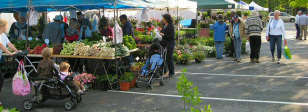
 RSS Feed
RSS Feed